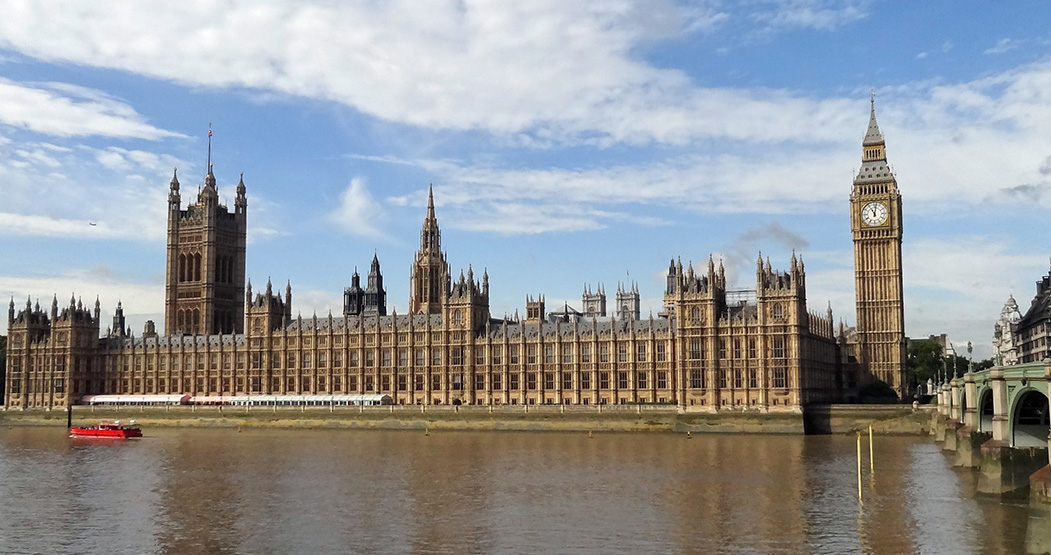 The UK Parliament’s Culture Media and Sport Select Committee has been examining the secondary ticketing market. The secondary market for events is dominated by four agencies – viagogo, eBay-owned StubHub and Ticket-master’s Get Me In! and Seatwave. These buy tickets to events in the primary market (i.e. from the events or their agents) and then resell them, normally at considerably inflated prices to people unable to get tickets in the primary market.
The UK Parliament’s Culture Media and Sport Select Committee has been examining the secondary ticketing market. The secondary market for events is dominated by four agencies – viagogo, eBay-owned StubHub and Ticket-master’s Get Me In! and Seatwave. These buy tickets to events in the primary market (i.e. from the events or their agents) and then resell them, normally at considerably inflated prices to people unable to get tickets in the primary market.
One example has grabbed the headlines recently. This is where viagogo was advertising tickets for an Ed Sheeran charity concert for £5000. The original tickets were sold for between £40 and £110, with the money going to the Teenage Cancer Trust. None of viagogo’s profits would go to the charity. The tickets were marked ‘not for resale’; so there was doubt that anyone buying a ticket from viagogo would even be able to get into the concert!
There are four major issues.
 The first is that the tickets are often sold, as in the case of the Ed Sheeran concert, at many times their face value. We examined this issue back in September 2016 in the blog What the market will bear? Secondary markets and ticket touts).
The first is that the tickets are often sold, as in the case of the Ed Sheeran concert, at many times their face value. We examined this issue back in September 2016 in the blog What the market will bear? Secondary markets and ticket touts).
The second is that the secondary sites use ‘bots’ to buy tickets in bulk when they first come on sale. This makes it much harder for customers to buy tickets on the primary site. Often all the tickets are sold within seconds of coming on sale.
The third is whether the tickets sold on the secondary market are legitimate. Some, like the Ed Sheeran tickets, are marked ‘not for resale’; some are paperless and yet the secondary ticket agencies are accused of selling paper versions, which are worthless.
The fourth is that multiple seats that are listed together are not always located together and so people attending with friends or partners may be forced to sit separately.
These are the issues that were addressed by the Culture Media and Sport committee at its meeting on 21 March. It was due to take evidence from various people, including viagogo, the agency which has come in for the most criticism. Viagogo, however, decided not to attend. This has drawn withering criticism from the press and on social media. One of the other witnesses at the meeting, Keith Kenny, sales and ticketing director for the West End musical Hamilton, described viagogo as ‘a blot on the landscape’. He said, ‘Ultimately, our terms and conditions say ticket reselling is forbidden. If you look at the way that glossy, sneaky site is constructed, they’ve gone an awful long way not to be compliant in the way they’ve built their site.’
 The Competition and Markets Authority launched an enforcement investigation last December into suspected breaches of consumer protection law in the online secondary tickets market. This follows on from an earlier report for the government by an independent review chaired by Professor Waterson.
The Competition and Markets Authority launched an enforcement investigation last December into suspected breaches of consumer protection law in the online secondary tickets market. This follows on from an earlier report for the government by an independent review chaired by Professor Waterson.
The government itself is considering amending the Digital Economy Bill to make it illegal to use bots to buy tickets in excess of the limit set by the event. Online touts who break this new law would face unlimited fines.
Articles
Touts to face unlimited fines for bulk-buying tickets online Independent, Roisin O’Connor (13/3/17)
Unlimited fines for bulk buying ticket touts BBC News (11/3/17)
Ticket touts face unlimited fines for using ‘bots’ to buy in bulk The Guardian, Rob Davies (10/3/17)
Ticket touts face unlimited fines in government crackdown on bots Music Week, James Hanley (11/3/17)
Government confirms bots ban and better enforcement in response to secondary ticketing review CMU, Chris Cooke (13/3/17)
The ‘Viagogo Glitch’: Why Fans Must Be Put First In The Secondary Ticketing Market Huffington Post, Sharon Hodgson (14/3/17)
Angry MPs accuse no-show Viagogo of ‘fraudulent mis-selling’ of Ed Sheeran tickets i News, Adam Sherwin (21/3/17)
 Ed Sheeran’s manager Stuart Camp on secondary ticketing BBC News, Stuart Camp (21/3/17)
Ed Sheeran’s manager Stuart Camp on secondary ticketing BBC News, Stuart Camp (21/3/17)
Fury at Viagogo no-show as MPs probe tickets on sale for thousands Coventry Telegraph, James Rodger (22/3/17)
Music fans given 10-step guide on how to tackle ticket touts Daily Record, Mark McGivern (20/3/17)
 Viagogo snubs MPs’ inquiry into online ticket reselling The Guardian, Rob Davies (21/3/17)
Viagogo snubs MPs’ inquiry into online ticket reselling The Guardian, Rob Davies (21/3/17)
Viagogo a No-Show at U.K. Hearing Into Secondary Ticketing: ‘Huge Lack of Respect’ Billboard, Richard Smirke (21/3/17)
 Daily Record campaign against ticket touts reaches Parliament but Viagogo don’t show up to answer claims Daily Record, Torcuil Crichton and Keith McLeod (22/3/17)
Daily Record campaign against ticket touts reaches Parliament but Viagogo don’t show up to answer claims Daily Record, Torcuil Crichton and Keith McLeod (22/3/17)
Ticketmaster is using its software — and your data — to take on ticket-buying bots recode, Peter Kafka (14/3/17)
Official sites and documents
The Culture, Media and Sport Committee holds a further evidence session on ticket abuse. Culture, Media and Sport Commons Select Committee (20/3/17)
CMA launches enforcement investigation into online secondary ticketing Competition and Markets Authority, Press Release (19/12/16)
Independent Review of Consumer Protection Measures concerning Online Secondary Ticketing Facilities Department for Business, Innovation and Skills, Professor Michael Waterson (May 2016)
Ticket abuse: ban digital ‘harvesting’ software says Committee Culture, Media and Sport Commons Select Committee (24/11/16)
Questions
- Use a demand and supply diagram to demonstrate how secondary ticket agencies are able to sell tickets for popular events at prices several times the tickets’ face value.
- If secondary ticket sites and ticket touts are able to sell tickets at well above box office prices, isn’t this simply a reflection of people’s willingness to pay (i.e. their marginal utility)? In which case, aren’t these sellers providing a useful service?
- How do secondary ticket agencies reduce consumer surplus? Could they reduce it to zero?
- See Tickets, the primary market ticket agency, has set up a secondary site, whereby fans can trade tickets with one another at a mark-up capped at just 5%. Will this help to reduce abuses on the secondary market, or is it a totally separate part of the market?
- Would it be a good idea for event organisers to charge higher prices for popular events than they do at present, but still below the equilibrium?
- How does the price elasticity of demand influence the mark-up that secondary ticket agencies can make? Illustrate this on a diagram similar to the one in question 1.
- What measures would you advocate to make tickets more available to the public at reasonable prices? Explain their benefits and any drawbacks.
- What would be the effect on prices if the use of bots could be successfully banned?

If you want a ticket for an event, such as a match or a concert, but the tickets are sold out, what do you do? Many will go to an agency operating in the ‘secondary market’. A secondary market is where items originally purchased new, such as tickets, company shares, cars or antiques, are put up for sale at a price that the market will bear.
The equilibrium price in a secondary market is where supply equals demand and the actual price will approximate to this equilibrium. In the case of tickets, this equilibrium price can be much higher than the original price sold by the venue or its agents. The reason is that the original price is below the equilibrium.
This is illustrated in the figure (click here for a PowerPoint). Assume that the total supply of tickets is Qs. Assume also that the official box office price is Pbo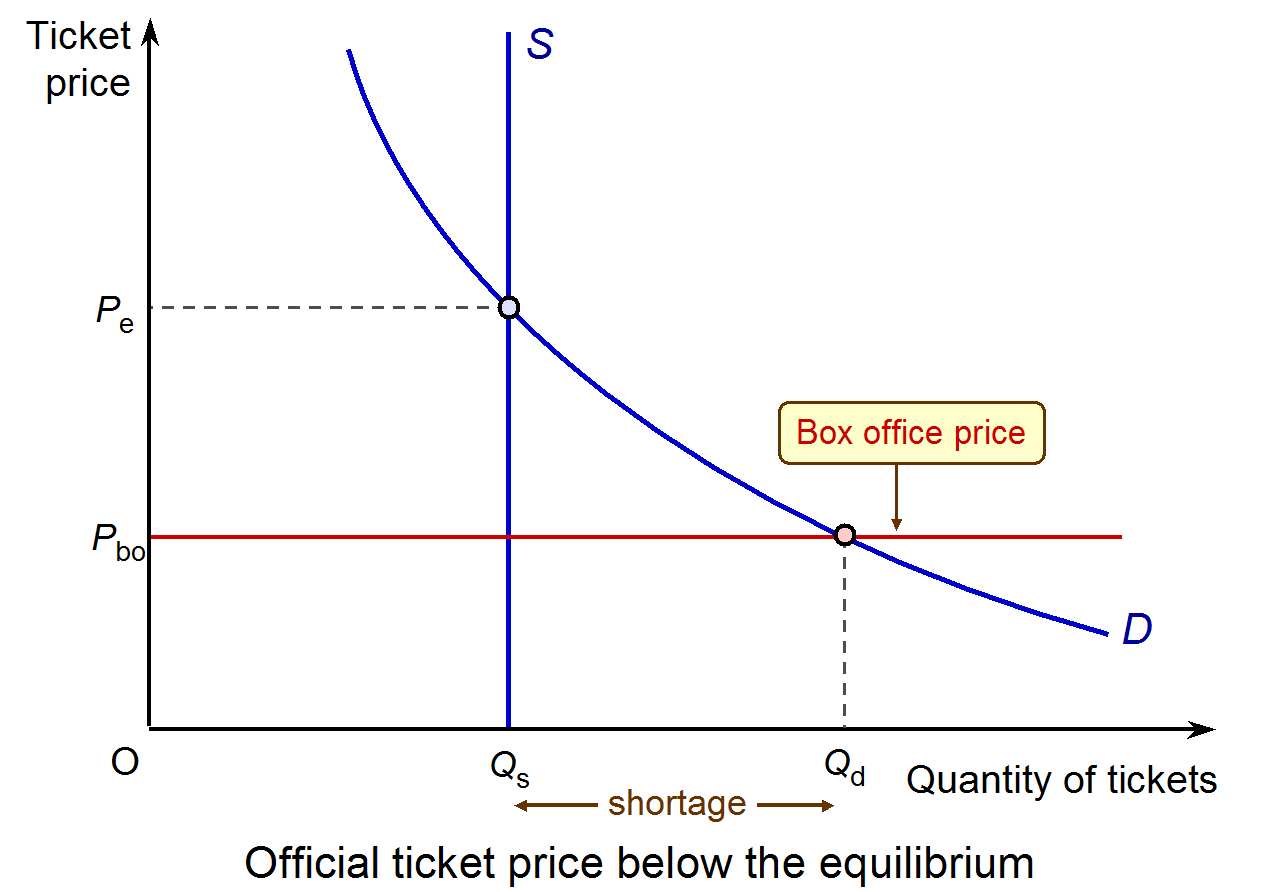 and that demand is given by the demand curve D. At the box office price demand exceeds supply by Qd – Qs. There is thus a shortage, with many fans unable to obtain a ticket at the official price. Many of you will be familiar with having to be as quick as possible to get hold of tickets where demand considerably outstrips supply. Events such as Glastonbury sell out within seconds of coming on sale.
and that demand is given by the demand curve D. At the box office price demand exceeds supply by Qd – Qs. There is thus a shortage, with many fans unable to obtain a ticket at the official price. Many of you will be familiar with having to be as quick as possible to get hold of tickets where demand considerably outstrips supply. Events such as Glastonbury sell out within seconds of coming on sale.
If you buy a ticket and then find out you cannot go to the event, you can sell the ticket on the secondary market through an online site or agency. Such agencies could be seen as providing a useful service as it means that otherwise empty seats will be filled. But if the equilibrium price is well above the original ticket price, there is the potential for huge gain by the agencies, who may pay the seller considerably less than the agency then sells the ticket to someone else.
What is more, the difference between the original price and the equilibrium price in the secondary market makes ticket touting, or ticket ‘scalping’, highly profitable. This is where people buy tickets with no intention of using them themselves but in order to sell them at much higher prices on the secondary market. Such ticket touting has been illegal for football matches since 1994 and was illegal for the 2012 London Olympics, but it is legal for plays, concerts, festivals and other events.
Ticket touts are often highly organised in obtaining tickets at official prices by buying early and using multiple credit cards and multiple identities to avoid systems that restrict the number of tickets issued to a card. They often use internet bots to mass purchase tickets the moment they go on sale.
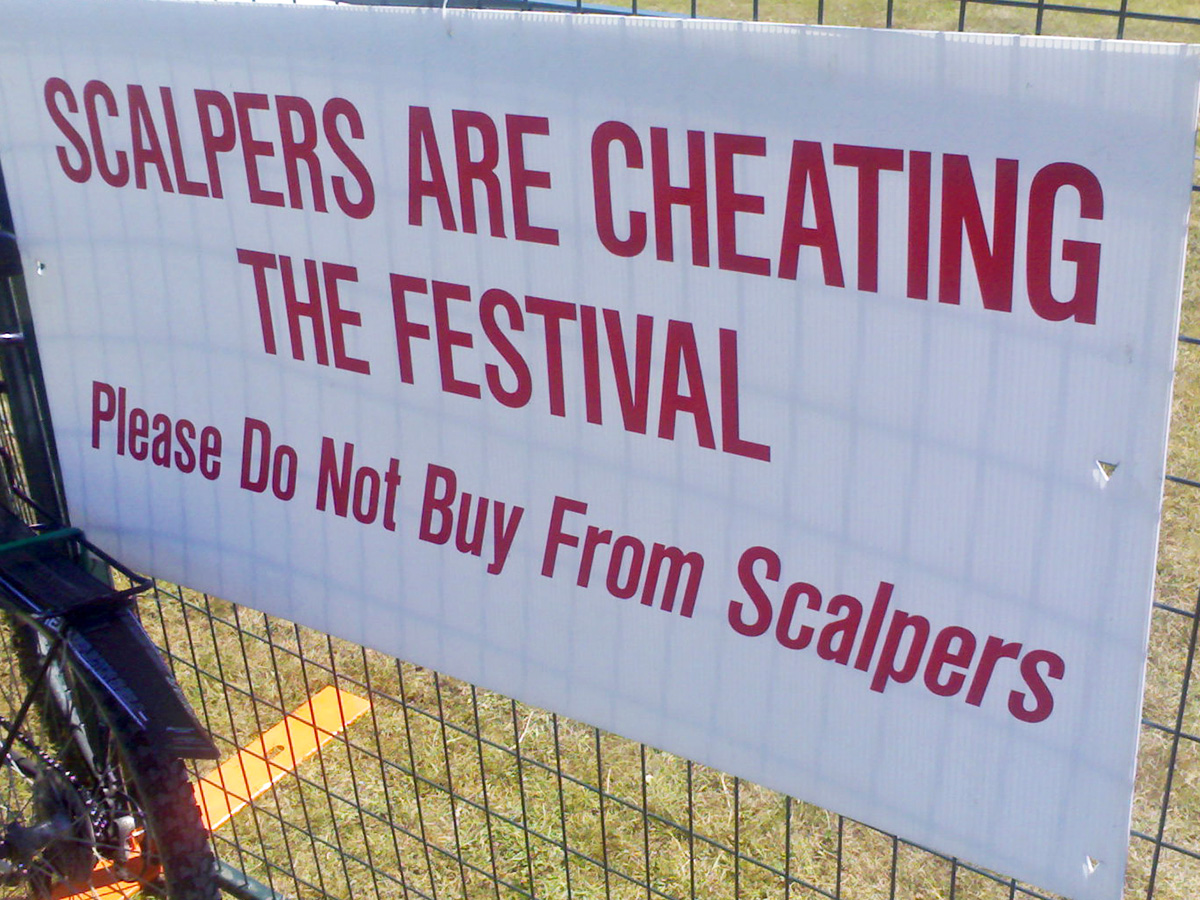
Those in favour of ticket touting argue that the high price in the secondary market is just a reflection of demand and supply (see the IEA article below). Ticket touting allows tickets to be directed to people who value them most and will get the greatest benefit from it. What is more, banning ticket touting, so the argument goes, would simply drive it underground.
Those against argue on grounds of equity. Ticket prices set below the equilibrium are designed to give greater equality of access to fans. Rationing on a first-come first-served system, either on the internet or by a queue, is seen to be fairer than one by ability/willingness to pay. A poor person may be just as keen to go to an event as a rich person and gain just as much enjoyment from it, but cannot afford the high equilibrium price. What is more, non of the profit from the higher prices reaches the event organisers or the artists or players. Yet the mark-up and hence profit made by ticket touts can be massive, as the first Observer article below shows.
Various measures are being tried to prevent ticket touting. One is the use of paperless tickets, with the number of tickets limited per person and with people having to show their ticket on their phones along with ID at the door or gate. If a person cannot attend, then the solution is a system where they can give the ticket back to the box office (perhaps electronically) which will re-sell it for them at the official price.
A government-backed investigation, the Waterson review reported in May 2016 and recommended that touts should be licensed and that there should be harsher penalties for firms that flout consumer rights law as applying to ticket sales. Whether this would be sufficient to bring secondary market prices down significantly, remains to be seen. In the meantime, organisers do seem to be trying to find ways of beating the touts through smarter means of selling.
Articles
MP Nigel Adams calls for secondary ticket marketing to be reformed Music Week, James Hanley (14/9/16)
Iron Maiden go to war with ticket touts BBC News, Mark Savage (22/9/16)
 The new age of the ticket tout BBC World Tonight, Andrew Hosken (25/5/16)
The new age of the ticket tout BBC World Tonight, Andrew Hosken (25/5/16)
Government urged to help music industry tackle ticket touts The Guardian, Rob Davies (13/9/16)
Ticket touts face licensing threat The Guardian, Rupert Jones (26/5/16)
How the ticket touts get away with bleeding fans dry The Observer, Rob Davies and Rupert Jones (15/5/16)
What sorcery is this? A £140 ticket for new Harry Potter play now costs £8,327 The Observer, Rob Davies and Laurie Chen (14/8/16)
Ticket touts made $3m from the last Mumford & Sons tour. $0 went back to the music industry. Music Business Woldwide, Adam Tudhope (6/9/16)
This is tout of order – join the Daily Mirror campaign to beat rip-off ticket resales Daily Mirror, Nada Farhoud (19/9/16)
Ticket touts: A muggle’s game The Economist (20/8/16)
Can We Fight Back Against The Robot Touts Ruining Live Music? Huffington Post, Andy Webb (6/9/16)
In defence of ticket touts Institute of Economic Affairs, Steve Davies (25/2/15)
Report
Consumer protection measures applying to ticket resale: Waterson review Department for Business, Innovation & Skills and Department for Culture, Media & Sport 26/5/16)
Guide
#Toutsout MMF & FanFair Alliance September 2016
Questions
- Why can ticket touts sell tickets above the equilibrium price shown in the diagram?
- In what ways could ticket touts be said to be distorting the market?
- How do ticket touts reduce consumer surplus? Could they reduce it to zero?
- Why may allowing ticket touting to take place result in empty seats at concerts or other events?
- Would it be a good idea for event organisers to charge higher prices for popular events than they do at present, but still below the equilibrium
- How does the price elasticity of demand influence the mark-up that ticket touts can make? Illustrate this on a diagram similar to the one above.
- Is it in ticket touts’ interests to adjust prices as an event draws closer, just as budget airlines adjust seat prices as the plane fills up? Could organisers sell tickets in the primary market in this way with prices rising as the event fills up?
- Discuss the various ways in which the secondary ticket market could be reformed? To what extent do these involve reforms in the primary ticket market?
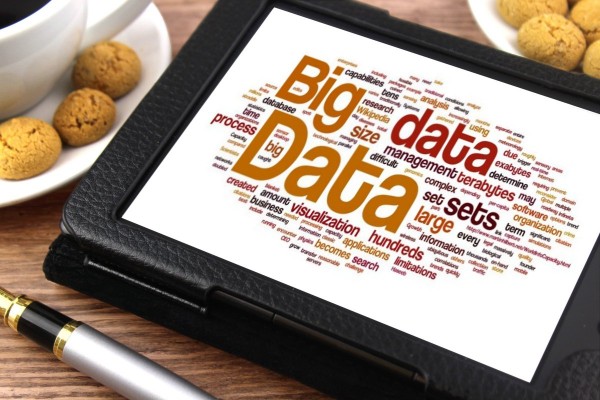 A number of famous Business Schools in the UK and US such as MIT Sloan, NYU Stern and Imperial College have launched new programmes in business analytics. These courses have been nicknamed ‘Big Data finishing school’. Why might qualifications in this area be highly valued by firms?
A number of famous Business Schools in the UK and US such as MIT Sloan, NYU Stern and Imperial College have launched new programmes in business analytics. These courses have been nicknamed ‘Big Data finishing school’. Why might qualifications in this area be highly valued by firms?
Employees who have the skills to collect and process Big Data might help firms to successfully implement a pricing strategy that approaches first-degree price discrimination.
First-degree price discrimination is where the seller of a product is able to charge each consumer the maximum price he or she is prepared to pay for each unit of the product. Successfully implementing this type of pricing strategy could enable a firm to make more revenue. It might also lead to an increase in economic efficiency. However, the strategy might be opposed on equity grounds.
In reality, perfect price discrimination is more of a theoretical benchmark than a viable pricing strategy. Discovering the maximum amount each of its customers is willing to pay is an impossible task for a firm.
It may be possible for some sellers to implement a person-specific pricing strategy that approaches first-degree price discrimination. Firms may not be able to charge each customer the maximum amount they are willing to pay but they may be able to charge different prices that reflect customers’ different valuations of the product.
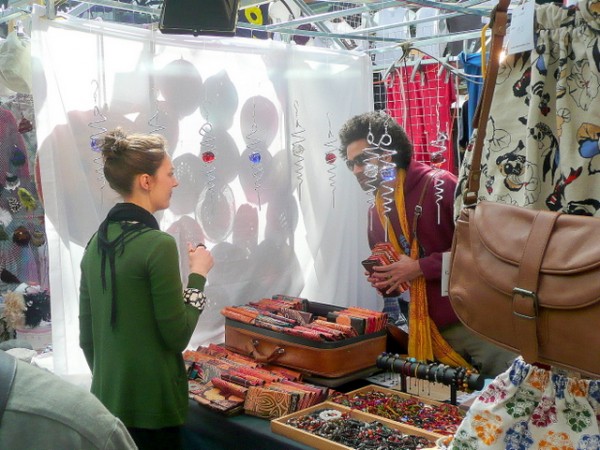 How could a firm go about predicting how much each of its customers is willing to pay? Traditionally smaller sellers might try to ‘size up’ a customer through individual observation and negotiation. The clothes people wear, the cars they drive and their ethnicity/nationality might indicate something about their income. Second-hand car dealers and stall-holders often haggle with customers in an attempt to personalise pricing. The starting point of these negotiations will often be influenced by the visual observations made by the seller.
How could a firm go about predicting how much each of its customers is willing to pay? Traditionally smaller sellers might try to ‘size up’ a customer through individual observation and negotiation. The clothes people wear, the cars they drive and their ethnicity/nationality might indicate something about their income. Second-hand car dealers and stall-holders often haggle with customers in an attempt to personalise pricing. The starting point of these negotiations will often be influenced by the visual observations made by the seller.
The problem with this approach is that observation and negotiation is a time-consuming process. The extra costs involved might be greater than the extra revenue generated. This might be especially true for firms that sell a large volume of products. Just imagine how long it would take to shop at a supermarket if each customer had to haggle with a member of staff over each item in their supermarket trolley!! There is also the problem of designing compensation contracts for sales staff that provide appropriate incentives.
However the rise of e-commerce may lead to a very different trading environment. Whenever people use their smart phones, laptops and tablets to purchase goods, they are providing huge amounts of information (perhaps unconsciously) to the seller. This is known as Big Data. If this information can be effectively collected and processed then it could be used by the seller to predict different customers’ willingness to pay.
Some of this Big Data provides information similar to that observed by sellers in traditional off-line transactions. However, instead of visual clues observed by a salesperson, the firm is able to collect and process far greater quantities of information from the devices that people use.
For example, the Internet Protocol (IP) address could be used to identify the geographical location of the customer: i.e. do they live in a relatively affluent or socially deprived area? The operating system and browser might also indicate something about a buyer’s income and willingness to pay. The travel website, Orbitz, found that Apple users were 40 per cent more likely to book four or five star hotel rooms than customers who used Windows.
Perhaps the most controversial element to Big Data is the large amount of individual-level information that exists about the behaviour of customers. In particular, browsing histories can be used to find out (a) what types of goods people have viewed (b) how long they typically spend on-line and (c) their previous purchase history. This behavioural information might accurately predict price sensitivity and was never available in off-line transactions.
Interestingly, there has been very little evidence to date that firms are implementing personalised pricing on the internet. One possible explanation is that effective techniques to process the mass of available information have not been fully developed. This would help to explain the growth in business analytics courses offered by universities. PricewaterhouseCoopers recently announced its aim to recruit one thousand more data scientists over the next two years.
Another possible explanation is that firms fear a backlash from customers who are deeply opposed to this type of pricing. In a widely cited survey of consumers, 91% of the respondents believed that first-degree price discrimination was unfair.
Articles
Big data is coming for your purchase history – to charge you more money The Guardian, Anna Bernasek and DT Mongan (29/5/15)
Big data is an economic justice issue, not just a Privacy Problem The Huffington Post, Nathan Newman (16/5/15)
MIT’s $75,000 Big Data finishing school (and its many rivals) Financial Times, Adam Jones (20/3/16)
The Government’s consumer data watchdog New York Times, Natasha Singer (23/5/2015)
The economics of big data and differential pricing The Whitehouse blog, Jason Furman, Tim Simcoe (6/2/2015)
Questions
- Explain the difference between first- and third-degree price discrimination.
- Using an appropriate diagram, explain why perfect price discrimination might result in an economically more efficient outcome than uniform pricing.
- Draw a diagram to illustrate how a policy of first-degree price discrimination could lead to greater revenue but lower profits for a firm.
- Why would it be so difficult for a firm to discover the maximum amount each of its customers was willing to pay?
- Explain how the large amount of information on the individual behaviour of customers (so-called Big Data) could be used to predict differences in their willingness to pay.
- What factors might prevent a firm from successfully implementing a policy of personalised pricing?
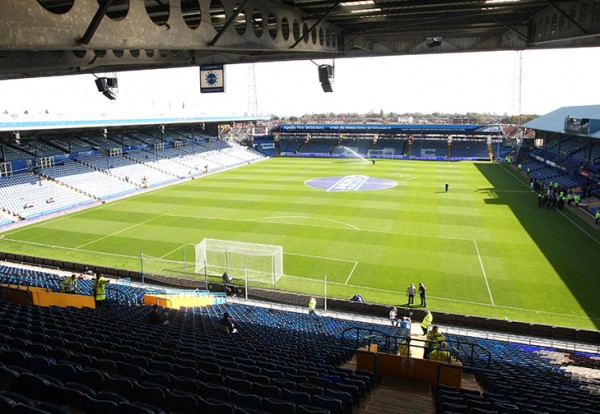 Most observers were once again left stunned by how much media companies are willing to pay to secure the rights to broadcast live games in the English Premier League (EPL). At the same time the method used to sell those rights is being investigated by Ofcom following complaints made by Virgin Media. Virgin Media actually requested that the auction was halted until the investigation was completed.
Most observers were once again left stunned by how much media companies are willing to pay to secure the rights to broadcast live games in the English Premier League (EPL). At the same time the method used to sell those rights is being investigated by Ofcom following complaints made by Virgin Media. Virgin Media actually requested that the auction was halted until the investigation was completed.
Between them, BSkyB and BT Sport have paid £5.136bn to purchase the rights to broadcast live matches in the EPL over a three-year period beginning in the 2016–17 season. This is a 71% increase in the price paid for the previous three-year deal which runs from 2013 to 2016 and cost £3.018bn. However, the headline figure hides some big differences between the amounts paid by the two companies.
How exactly are the rights sold? The broadcast rights for the 168 live matches are split up into seven different packages labelled A through to G and are placed in seven different auctions. The type of auction used by the EPL is a sealed bid auction. Interested companies are invited to make an offer for any of the packages. However, when they make a bid they do not know (a) if other firms have also made a bid and (b) the size of any other bids. Another constraint is that one firm is not allowed to win more than five of the auctions. When the auction finishes the EPL only releases information about the winning offers. It never provides information about any of the failed bids.
Some of the packages are worth more than others to the broadcasters. The first five packages (A–E) each contain the rights for 28 games per season, while the other two packages (F and G) contain the rights for 14 matches. In some of the packages all of the games kick off at the same time and on the same day. For example all 28 games in package ‘A’ kick off at 12.30pm on a Saturday. Others contain more of a mixture. Some of the games in Package E take place on a Monday evening. while others take place on a Friday evening. Given the potential advertising revenue and number of viewers, the most valuable package is D, which has 28 games that kick off at 4.00pm on a Sunday.
Another factor that influences the value of a package is the number of ‘first picks’. In any given week, more than one broadcaster might want to screen the same match. To overcome this problem, each package is allocated a number of first, second, third, fourth and fifth ‘picks’. For example, package D comes with 18 first and 10 fourth round picks. This means that whichever company wins this package will get first choice on the games they want to broadcast on 18 occasions a year. Package C contains no ‘first picks’ but offers 15 second, 4 fourth and 7 fifth round picks. There is also a maximum and a minimum limit on the number of times games including a specific team can be broadcast.
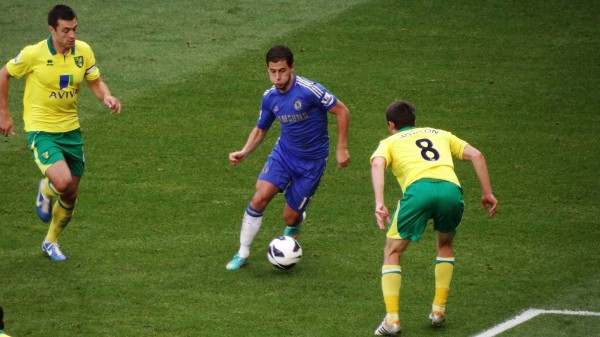
BSkyB won the auctions for packages A, C, D, E and G for a price of £4.17bn. This means that it will be paying £1.396bn to broadcast 126 live games per season. This is an average payment of £11,031,700 per game. In the previous deal it paid £760million for the rights to broadcast 116 live games per season. This is an average payment of £6,551,724 per game. The new deal represents a cost increase of 68% per game. However, the number of first picks BskyB has secured in the new deal increases from 20 to 26.
BTSport won the auctions for packages B and F for a price of £960m. This means that it will be paying £320m for the rights to broadcast 42 live games per season. This is an average payment of £7,619,048 per game. In the previous deal it paid £246 million per year for the rights to broadcast 38 live games per season. This is an average payment of £6,473,684 per game. The new deal represents an increase in costs of 17.7% per game for BT Sport – a much lower figure than for BSkyB.
BSkyB has stated that it will cover the increase in the price it has paid for the rights with efficiency savings. However, many observers believe that it will ultimately result in significant increases in the subscription rates for SkySports. The impact of the deal on BskyB’s profit may well depend on the willingness of its customers to pay higher prices. What is the price elasticity of demand for SkySports at the current subscription rates they are charging?
There is still some uncertainty about the deal following Ofcom’s decision to investigate the legitimacy of the method used by the EPL to auction the rights. Virgin Media made a formal complaint in September 2014 about the collective selling of the live broadcast rights and argued that it was in breach of competition law. The investigation by Ofcom will make a judgment about whether the joint selling of the rights by the EPL is a contravention of Chapter I of the Competition Act 1998 and/or Article 101(1) of the Treaty on the Functioning of the European Union. An initial announcement will be made in March.
Premier League set to announce record £4.4bn TV rights deal BBC Sport (10/2/15)
Premier League TV rights: What does deal mean for fans & clubs BBC Sport, Ben Smith (11/2/15)
How Sky paid £4m more per Premier League match than BT The Telegraph, Ben Rumsby (11/2/15)
Premier League TV deal: Windfall must benefit grass roots and England The Telegraph, Henry Winter (10/2/15)
Sky and BT retain Premier League TV rights for record £5.14bn The Guardian, Owen Gibson (10/2/15)
Premier League TV rights: Sky Sports and BT Sport win UK broadcasting rights as price tops £5billion Independent, Tom Peck (10/2/15)
Questions
- Draw a demand curve for package A and package D of the live broadcast rights. Which one do you think will be furthest to the right? Explain your answer.
- What are the potential benefits to the EPL of not revealing the details of any of the losing bids?
- Explain how the price elasticity of demand is a useful concept for assessing the impact of the new deal on the profits of BSkyB and BTSport.
- Given the impact of the new deal of the size of Parachute payments, what impact might it have on the level of competitive balance in the Championship?
- Find out the key provisions of Chapter I of the Competition Act 1998 and Article 101(1) of the Treaty on the Functioning of the European Union.
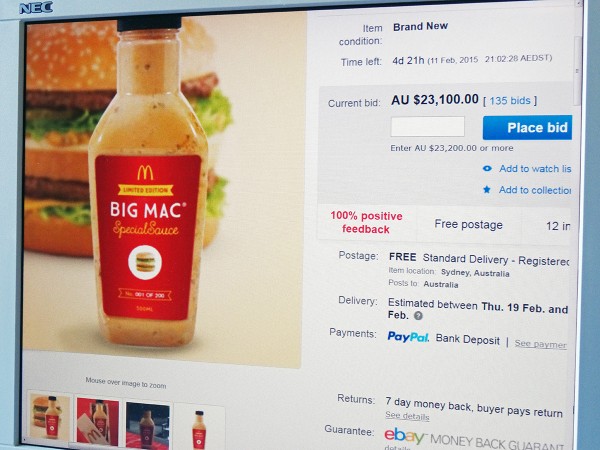 McDonalds is one of the most recognised names in the world and its iconic product, the Big Mac, is an obsession for many people – though I have to confess that I have never had one. McDonalds is taking advantage of this fact by auctioning off a bottle of its secret Big Mac sauce. The proceeds will go to charity.
McDonalds is one of the most recognised names in the world and its iconic product, the Big Mac, is an obsession for many people – though I have to confess that I have never had one. McDonalds is taking advantage of this fact by auctioning off a bottle of its secret Big Mac sauce. The proceeds will go to charity.
McDonalds has around 36 000 stores around the world, located in over 100 countries. The Big Mac is sold in all of these stores and the famous sauce is available there for a pretty small price. However, on eBay, this bottle of sauce has already reached a bid of AU$23 100 (£11 800)! The 500m bottle is only being auctioned in Australia and with a few days before the auction finishes, the price may get still higher.
So, why are people prepared to pay such a high price for a bottle of sauce that is readily available on a Big Mac and which, in Australia, will be sold in small tubs throughout this month?
The advert on eBay suggests that the bottle is being set free and is ‘rarer than a spot on Bondi beach on New Years Day’. As we know, when products become scarce their price tends to rise. This auction will be the first time that this sauce is available, as normally the sauce is dispensed straight onto the burger. The ingredients of this famous sauce are known, but the recipe for making it is not. Perhaps it represents an opportunity for someone to try to re-create it!
An auction is an interesting mechanism to receive the highest price for any product. Most people have a maximum willingness to pay for something and if they pay less than that, they will receive some consumer surplus. However, with an auction, it can be a good way for the seller to force consumers to bid their maximum price and hence this can reduce the consumer surplus.
Of course, in this auction only the highest bidder will actually pay and so it will only be their consumer surplus that is affected. However, other auction designs, such as an ‘All-pay’ auction can extract the full consumer surplus from bidders. Mr Lollback, the Chief Marketing Officer said:
‘We’re excited to be auctioning off the first-ever bottle of Big Mac sauce for a cause we are passionate about… It’s going to be interesting to see just how much people are prepared to pay for such a sought after commodity.’
The final price will certainly be interesting and, with other bottles of this sauce available, we will have to wait and see whether or not further auctions take place or if other mechanisms of delivering the sauce to the public appear. The following articles consider the Big Mac sauce auction.
McDonald’s Big Mac sauce auction attracts $18,000 bid BBC News (3/2/15)
Liquid Gold! Macca’s auction off the only bottle of its trademark Big Mac special sauce in Australia … and bids have already reached $23,000 Mail Online, Leesa Smith (3/2/15)
 Bottle of McDonald’s secret Big Mac sauce up for auction USA Today, Jessica Durando (3/2/15)
Bottle of McDonald’s secret Big Mac sauce up for auction USA Today, Jessica Durando (3/2/15)
McDonald’s Big Mac special sauce yours to own from today The Telegraph, Richard Noone (29/1/15)
Questions
- Why does the price of a product rise when it is scarce? Use a diagram to explain this.
- What is consumer surplus and how can a firm aim to extract as much of this as possible? Why would a firm want to do this? Use a diagram to illustrate the concept of consumer surplus and how it can change.
- Why can an auction push up the market price of a product?/li>
- Given that the Big Mac sauce is available on all Big Macs, which can be purchased for a very low price, what explanation can be given for people being prepared to pay over £10,000?
- When are auctions a good mechanism to sell a product?
- What are the different types of auctions that can occur? How do they vary in terms of the price that can be achieved?
 The UK Parliament’s Culture Media and Sport Select Committee has been examining the secondary ticketing market. The secondary market for events is dominated by four agencies – viagogo, eBay-owned StubHub and Ticket-master’s Get Me In! and Seatwave. These buy tickets to events in the primary market (i.e. from the events or their agents) and then resell them, normally at considerably inflated prices to people unable to get tickets in the primary market.
The UK Parliament’s Culture Media and Sport Select Committee has been examining the secondary ticketing market. The secondary market for events is dominated by four agencies – viagogo, eBay-owned StubHub and Ticket-master’s Get Me In! and Seatwave. These buy tickets to events in the primary market (i.e. from the events or their agents) and then resell them, normally at considerably inflated prices to people unable to get tickets in the primary market. The first is that the tickets are often sold, as in the case of the Ed Sheeran concert, at many times their face value. We examined this issue back in September 2016 in the blog What the market will bear? Secondary markets and ticket touts).
The first is that the tickets are often sold, as in the case of the Ed Sheeran concert, at many times their face value. We examined this issue back in September 2016 in the blog What the market will bear? Secondary markets and ticket touts). The Competition and Markets Authority launched an enforcement investigation last December into suspected breaches of consumer protection law in the online secondary tickets market. This follows on from an earlier report for the government by an independent review chaired by Professor Waterson.
The Competition and Markets Authority launched an enforcement investigation last December into suspected breaches of consumer protection law in the online secondary tickets market. This follows on from an earlier report for the government by an independent review chaired by Professor Waterson. Ed Sheeran’s manager Stuart Camp on secondary ticketing BBC News, Stuart Camp (21/3/17)
Ed Sheeran’s manager Stuart Camp on secondary ticketing BBC News, Stuart Camp (21/3/17) Viagogo snubs MPs’ inquiry into online ticket reselling The Guardian, Rob Davies (21/3/17)
Viagogo snubs MPs’ inquiry into online ticket reselling The Guardian, Rob Davies (21/3/17) Daily Record campaign against ticket touts reaches Parliament but Viagogo don’t show up to answer claims Daily Record, Torcuil Crichton and Keith McLeod (22/3/17)
Daily Record campaign against ticket touts reaches Parliament but Viagogo don’t show up to answer claims Daily Record, Torcuil Crichton and Keith McLeod (22/3/17)






